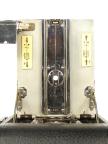TEB No 5 Folding Camera
Chas Tylar & England Bros Ltd
| Name: | TEB No 5 |
| Manufacturer: | Chas Tylar & England Bros Ltd |
| Country of Origin: | England |
| Construction: | Conventional folding bed camera for rollfilm and plates. Leather covered wooden body with aluminium folding bed. |
| Production Period: | TBC |
| Plate / Film Size: | 3¼ x 4¼" plates and 118 rollfilm |
| Lens: | Rapid-Rectilinear, f8, iris diaphragm to f44 |
| Shutter: | B & L Unicum shutter, speeds 1 - 1/100, B, T |
| Movements: | Rising front |
| Dimensions (w x h x l): | 11 x 22 x 5 cm (closed) |
| Date of this Example: | c1902 |
| Serial Number: | Serial number 174 on inner edge of track on lens board |
| Availability: |
|
| Inventory Number: | 632 |
|
Photos copyright © 2015 David Purcell. Do not use without permission. |
Description
The TEB No 5 is a folding camera of fairly conventional format, for plates and rollfilm. The name is derived from the initials of the maker, Tylar & England Bros.
I believe that this camera took 118 film (introduced in 1900), based on the dimensions of the wooden spool still in the camera.
The camera has two focusing scales for film and plate. I has deep mauve leather bellows. The back is hinged at the lower edge and released with a catch on the top edge, under the handle. TOpening the back reveals unpolished wooden interior.
This example has a separate grid style flip-up finder fitted to the side of the camera body, which may be contemporary but likely not original to the camera.
It is likely these were made in Germany and then badged as TEB cameras. In this case the name is shown on the plate above the aperture markings on the shutter and nowhere else. The camera is similar in form to early Huttig Lloyd or Krugener Halios cameras, though not identical to any specific examples found so far.
Notes
I suspect this may be a fairly early model as it differs to others I have seen as it has the viewfinder mounted on the folding bed rather than the lens standard. It has also has an unusual set up for the film winder, as this is held in place with a sprung catch, which has to be moved through 90 degrees or so to allow the winder to be removed and, in turn, for the film spool to be removed from the camera.
![[ ]](../../images/unchecked.png)
![[x]](../../images/checked.png)












